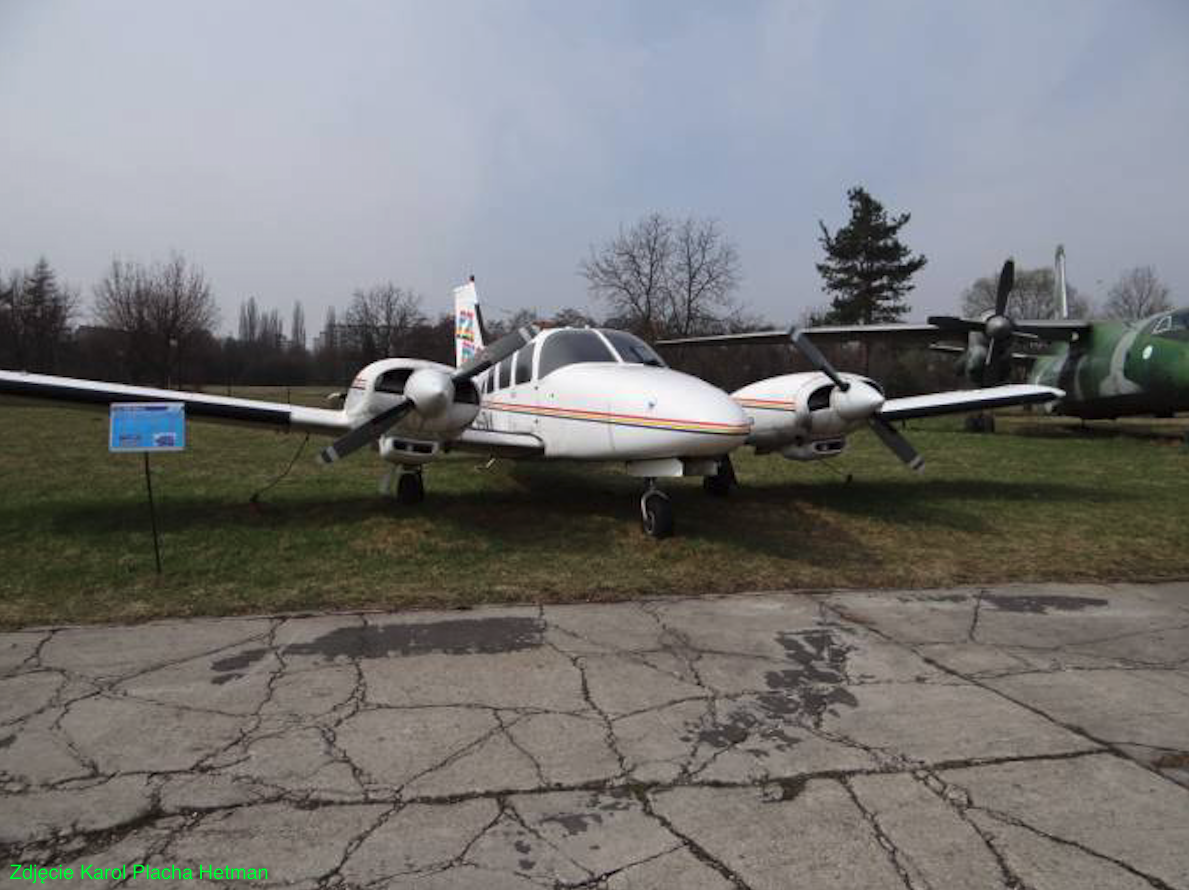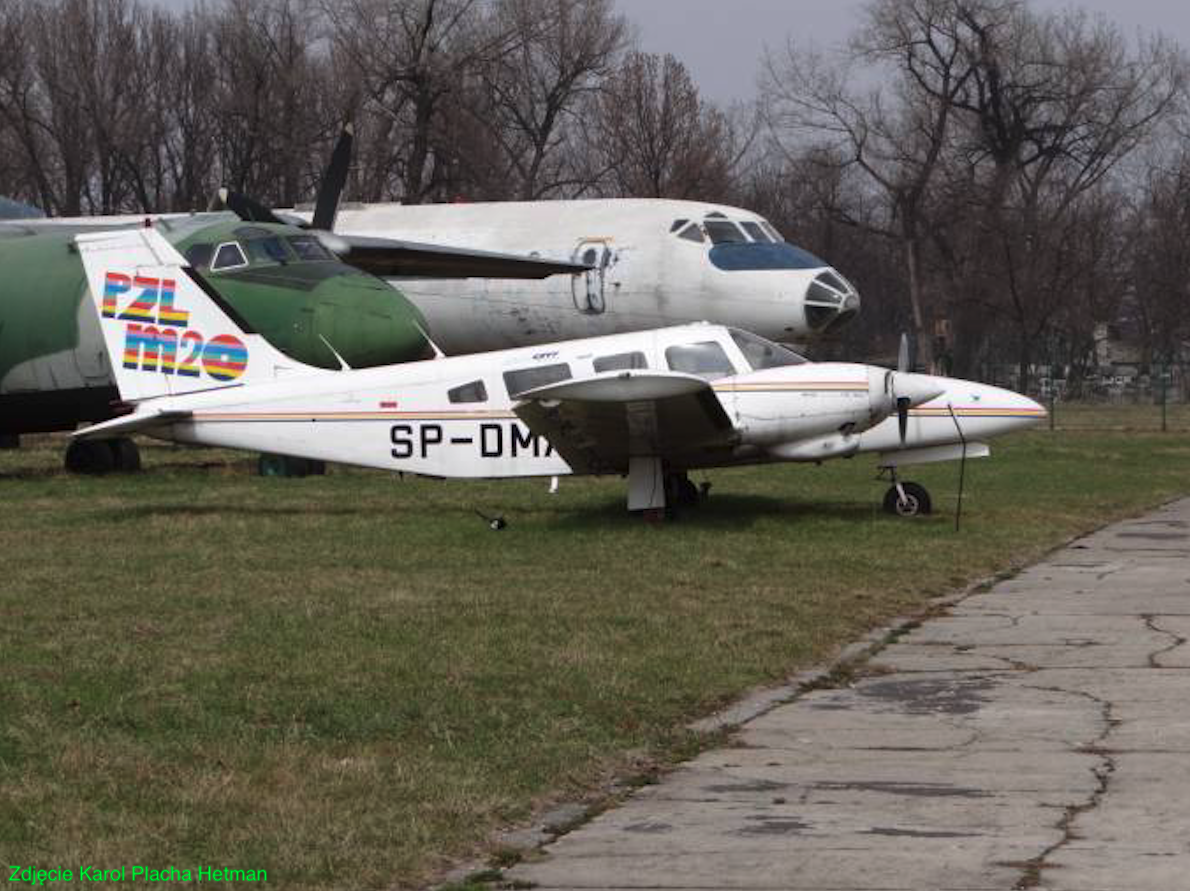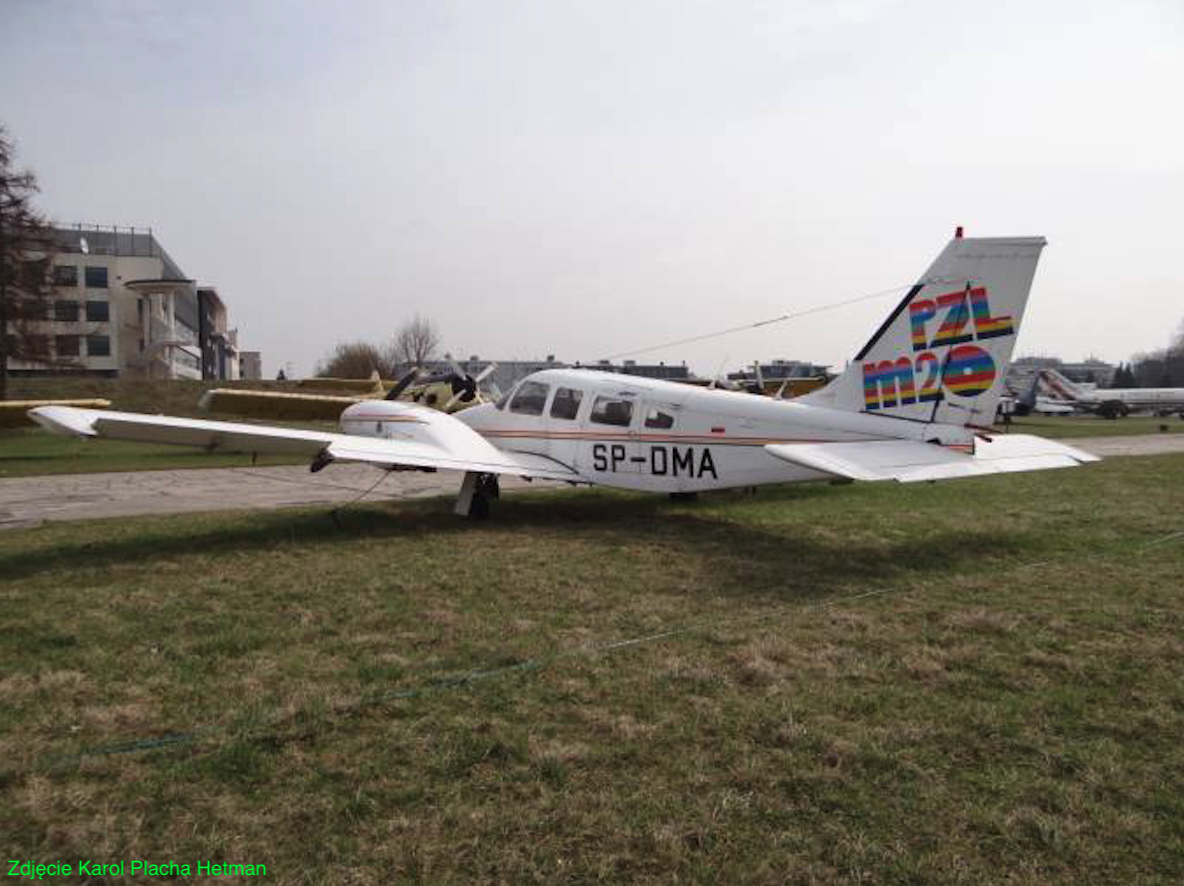Kraków 2012-07-22
PZL-Mielec M-20 Mewa / Piper PA-34 Seneca II. Część 2.
255b Section 25.07.1979 year. Poland.
PZL M-20 Mewa is a disposable aircraft produced in PZL Mielec.
PZL Franklin.
To be honest, at the turn of the 1960s and 1970s, the Polish Aviation Industry did not have a modern piston engine for lightweight aircraft structures. There were two solutions to this situation. Allocate significant amounts of money for own development research of Polish structures, or purchase licenses. Both solutions had advantages and disadvantages. Nevertheless, the first solution could fail and required 4-5 years of work. The second solution gave effect within a few months. Therefore, it was decided to purchase a license. At that time (early 70s), the following companies dominated the field of small aircraft engines; Lycoming (building aircraft engines since 1927), Continental (building aircraft engines since 1928), Franklin (building aircraft engines since 1938).
After negotiations, the Polish authorities chose the offer of Franklin Aircooled Motors Corporation located in Syracuse, New York. Poland has purchased licenses for the Franklin 6A-350 engine with a power of 162 kW for WSK PZL-Rzeszów. The engine was adapted to Polish production capabilities. The improved engine received the designation PZL-Franklin 6A-350 C.
Franklin Company.
The history of Franklin Aircooled Motors Corporation begins in the 19th century. In 1893, Herbert Franklin founded a foundry specializing in the construction of machine bodies. Gears and bearing covers as well as many other elements were also produced. In 1901, the company developed an air-cooled engine for the first automobiles. Serial production of the engine started in 1902. As a further consequence, the company began to build serial cars. The crisis of the 30s of the 20th century led the company to collapse. For 30 years, the company has produced about 150,000 cars. The revival of the company took place in 1934, when the production of car engines was resumed. The development of aviation meant that the company began to develop aircraft engines based on car engines. The first serial aircraft engine was produced in 1938. It was a 4-cylinder boxer engine. Already at the end of 1938, there was already a whole family of these 4-cylinder engines. They had a power of 29.4-36.8 kW (40-50 hp). In 1939, engines with a power of 36.8-44.2 kW (50-60 HP) appeared, and in 1940, with a power of 62.6-66.2 kW (85-90 HP). The latter engine was used as the drive of the popular Stinson-108 Voyager tourist aircraft and was used in military aircraft. The 4-cylinder Franklin engine with the gearbox was officially adopted in 1943 as the drive for light military aircraft.
Here are the basic data of these engines;
4AC-176-BA2 (4-cylinder) 47.8 kW (65 hp) at 2,300 rpm automotive gasoline 73 octane. 4AGC-199-H3 (4-cylinder) 75-83 kW (102-113 hp) at 3,500 rpm with 0.63:1 gearbox, propeller 2,200 rpm. 6ACV-403 (6 cylinder) for Nash-Kelvinator licence-produced helicopters, 180 kW (245 hp). 6AC-298-F3 (6 cylinders) 95.7 kW (130 hp) at 2,550 rpm. 6ACG-298-P3 (6 cylinders) 117.8 kW (160 hp) at 3,200 rpm, geared motor. 8AC (8-cylinder). 12AC (12-cylinder). All of the listed engines ran on motor gasoline with an octane rating >80.
The following years are a constant improvement of the engines. New metal alloys were used. Efficiency was increased while fuel consumption was reduced. 4 and 6 cylinder versions were especially developed. In 1962, a 177 kW 6VS engine was developed. In 1966, another 162 kW 6A-350 C1 engine was built. In 1962, the Franklin company was producing; 10 types of 6-cylinder engines (147.2-177 kW), 1 type of 4-cylinder engine, 1 type of 2-cylinder engine. Franklin engines were used in helicopters and airplanes; sports, tourist, sanitary, liaison and other. They were used in American, Italian, Brazilian and French aircraft.
Users of PZL M-20 Mewa aircraft.
The urgent need for professional training of pilots for the needs of commercial aviation resulted in the establishment of the Aviation Personnel Training Center (OSPL) on January 1, 1977. The assumption was to train groups of students of the pilot specialization of the Rzeszów University of Technology in an integrated way, mainly for the needs of LOT Polish Airlines. The basic aircraft operated in OSPL was the Antonov An-2 aircraft. Subsequently, the Center was equipped with the following aircraft: PZL-110 "Koliber", PZL-104 "Wilga". The problem was that each of these planes was single-engined. Therefore, it was beneficial to acquire M-20 Mewa aircraft. Rzeszów University of Technology had 3 copies.
In 1992, the Center bought an FNPT II type simulator based on the M-20 Mewa aircraft, while the An-2 and PZL-104 Wilga aircraft were gradually decommissioned, replaced by the modern TB-9 Tampico and TB-20 Trinidad. Fifth-year students completed, as part of aviation practice, a flight training program with international flights to Western Europe, on the PZL M-20 Mewa aircraft, obtaining a professional pilot’s license along with instrument flight rights (IFR) on multi-engine aircraft.
Around 1995, one of the M-20 copies was adapted at WSK PZL Rzeszów again for PZL-Franklin engines, the production of which was launched at this plant.
Since 2001, the vast majority of the pilot training cycle has been carried out in accordance with the European requirements – Common Aviation Regulations (JAR) – Flight Crew Licensing (FCL). Due to the completed service life and the lack of funds for repairs of the M-20 Mewa aircraft, they were withdrawn from service in 2009. Nevertheless, the Rzeszów University of Technology stayed with the Piper family planes, buying two PA-34 Seneca V planes in 2010. The new planes received the same markings as the PZL M-20 Mewa planes used in OKL not so long ago: SP -TUC and SP-TUD. The purchase of the aircraft was possible thanks to funds from the Development of Eastern Poland program.
This situation confirms the fact that the M-20 Mewa aircraft were still needed by the Polish economy. It is unfortunate, however, that the purchase was made only when the production of the M-20 in Mielec was definitely liquidated. This is another example of the deliberate liquidation of the Polish Aviation Industry, carried out by Masonic forces.
The M-20 aircraft went to the Polish Medical Air Rescue. They replaced the Czechoslovak Morawa planes there. In 2007, part of the PZL-Mielec company was bought by the Sikorsky Aircraft Corporation. The company had no intention of applying for a European Surveillance Certificate (EASA), without which all aircraft would not be allowed to fly after March 28, 2007. However, a settlement was reached and the certificate extended. Therefore, M-20 aircraft could continue to fly. The M-20s in the Polish Medical Air Rescue were replaced by the Piaggio P.180 Avanti II. The M-20 SP-MXB aircraft was operated by the Polish Medical Air Rescue. After the end of operation, it stood as a monument at the entrance to the Bemowo Airport.
At least one M-20 Mewa aircraft has been delivered to KGHM Polska Miedź. The aircraft with registration numbers SP-NEA No. 1 AH 002-05, presumably came to the company in 1996. It was operated until 2007, when it was put up for sale. By then, the aircraft had flown approximately 1,500 hours. Starting price PLN 160,000. It was bought by an individual and in 2009, it was still flying.
One M-20 went to the 103rd Aviation Regiment of the Vistula Military Units of the Ministry of Internal Affairs based at the Bemowo Airport. It was in 1995. The regiment was disbanded in 2000, and the plane was handed over to the Border Guard. The aircraft received the registration SN-50YG. One more aircraft M-20 SP-VSA served in the Border Guard.
The SkyTaxi company was founded in 2000. The first place of business of the company was the airport in Polska Nowa Wieś near Opole. There was their first PZL M-20 Mewa aircraft, registration SP-MRA. They flew to Warsaw with the first client. The plane was stationed at the airport of the Aero Club of Opole until the first winter. At that time, Strachowice Airport was chosen as a permanent stop for the SkyTaxi machine. Since 2004, SkyTaxi has the JAR-OPS 1 certificate awarded by the Civil Aviation Authority in Poland. At that time, the company’s aircraft park was enlarged by two SAAB 340 aircraft (SP-MRB, SP-MRC), and a little later the M-20 aircraft was withdrawn from service. On April 10, 2010, after the Smolensk attack, Jarosław Kaczyński, brother of the killed President of the Republic of Poland, Professor Lech Kaczyński, flew to Vitebsk on board the SAAB 340 airliner.
AEROGRYF is a private aviation company, founded in 1990, it is currently (2010) the operator of 30 aircraft that can be used for various types of air services. The offer is very rich. The company deals with, among other things, training within the certified Aviation Training and Retraining Centre. The offer of the Center includes theoretical classes and practical training both on a flight simulator and in flight on M-20 Mewa (SP-DMA) and Cessna-172 aircraft. M-20 SP-DMA was still in operation in 2009, but in 2011, it went to MLP in Krakow.
The M-20 aircraft was also operated by the Royal-Star company, which was established in 1995. Its main industry was refrigeration and refrigeration installations. Since the company operated at the Mielec Airport, it also decided to appear on the aviation market by creating a training center under the name Royal-Star Aero. The school had; four Cessna 152 aircraft (SP-CAT, SP-KOI, SP-KMV, SP-KMG), Piper PA-28 Arrow (SP-KMT), PZL M-20 Mewa SP-KFE and Piper PA-34 Saneca II SP – RBM.
On January 1, 2006, there were 14 PZL M-20 Mewa aircraft in the Polish register of aircraft, including: Aeroclub of Poland – 1 copy, Aviation Training Center – 4 copies, Lotnicze Pogotowie Ratunkowe – 3 copies, disposable – 5 copies, private – 1 copy. In 2007, they were used e.g. in the following companies: Aerotechnika, Sky Taxi, Civil Partnership Ibex-UL. In 2006, 1 PZL M-20 Mewa aircraft was on the state of the Border Guard Aviation.
Summary.
The PZL M-20 Mewa plane was not lucky from the very beginning. It did not fit in the script written in Moscow for the Polish Aviation Industry. This is also evidenced by the small number of photos of the aircraft published in the daily press. After 1989, the machine was also not a great success. Successive governments of the Republic of Poland sought to sell off the Polish Aviation Industry. PZL Mielec became the first victim. With the exception of the cabinets of Prime Minister Jan Olszewski and Prime Minister Jaroslaw Kaczyński, all other prime ministers practiced anti-Polish and Masonic economics.
By 1998, less than 30 were built. Production of the M-20 continued intermittently until 2002, after which it was frozen. The PZL Mielec company fell into a debt spiral and collapsed. The collapse of such a well-known company as PZL Mielec was a deliberate action. The PZL Mielec plants were not supported in promoting their products abroad, which was and is commonly done by the governments of the USA, UK, France and Brazil. The I-22 Iryda and M-20 Mewa programs were destroyed. The program of the PZL M-28 Bryza aircraft was stopped. The screen was the slogan that the Eastern Market had collapsed and we had nowhere to export, which was not very true. This state lasted until 2007, when part of the PZL Mielec plant was bought by Sikorsky. This company was not interested in continuing the work and production of M-20 aircraft, leaving only the M-18 Dromader agricultural aircraft and the M-28 transport aircraft.
Another problem turned out to be the accession of the Republic of Poland to the European Union. The Polish negotiators of the conditions of accession to the European kolkhoz accepted all conditions uncritically. As a result, the effects were visible even in flight training using PZL M-20 aircraft. In 2007, the PZL M-20 aircraft faced the specter of its complete decommissioning due to the non-renewal of certification. (The former manufacturer of PZL Mielec-Sikorsky was not interested in this). According to the provisions of JAR FCL 1.125 and JAR FCL 1.155, they could not be used for training young pilots. Therefore, the Civil Aviation Authority has made efforts to obtain a long-term derogation from the application of European regulations. However, the president of the office imposed additional conditions on the owners of the M-20 aircraft, which they will have to meet before starting flights with trainees. In 2008, the Joint Aviation Authorities (JAA) agreed to waive some of the regulations in relation to the PZL M-20 Mewa. This allowed the aircraft to continue to be used in flight schools. JAA represents the aviation authorities of most European countries, dealing with flight safety issues. It is not a body directly approving the regulations, but it serves to standardize them.
The reluctance of the Polish authorities to the M-20 Mewa aircraft was also manifested in the proceedings of the State Commission for Investigation of Aircraft Accidents, headed by Edmund Kich. On October 19, 2010, there was an air incident of the M-20 aircraft, registration SP-FMD. During the flight near Ławica Airport, the right engine started to run unevenly. The plane landed safely and without any problems. The incident was reported to SCAAI. The problem is that the commission in the report referred to the aircraft as Piper PA-34 Seneca SP-FMD. This is an obvious erasure from the history of the Polish Aviation Industry of the production of PZL M-20 Mewa aircraft at the PZL Mielec plant.
PZL M-20 Mewa at the Polish Aviation Museum in Krakow.
On September 2, 2011, the Polish Aviation Museum in Czyżyny received another exhibit from the RWY of the former Rakowice-Czyżyny airport. The PZL M-20 Mewa SP-DMA aircraft flew from Szczecin to Krakow. The aircraft served for many years at the AEROGRYF company, and the permanent base was the Goleniów Airport.
Continued in the next chapter.
Written by Karol Placha Hetman



